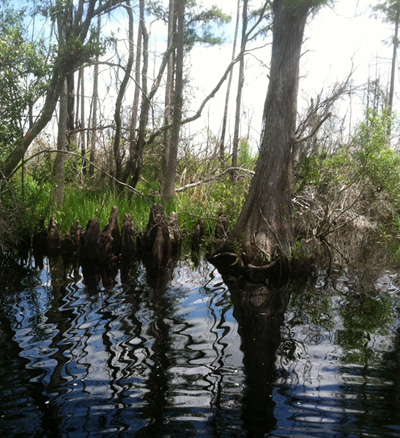The Okefenokee Swamp is one of Mother Nature’s mysterious places. Straddling the Georgia–Florida border in the United States, this 438,000-acre wetland offers intriguing landscapes, abundant wildlife and a glimpse into the past.
Land of the Trembling Earth
According to the Okefenokee National Wildlife Refuge Visitor Center, the swamp bottom “is sand, covered with peat. Methane gas deep in the peat propels large clumps of peat to “blow up” (rise or float) to the surface. Over time, these peat masses sprout plants and attract wildlife. They look like islands – but they’re not solid, and they’re not anchored to the swamp bottom. If a person or a large animal (like a bear) walks on peat blow-up, the ground trembles and the trees shake. Native Americans called these places ‘O-ki-fin-o-ke,’ Land of the Trembling Earth.”
 Boating on tannin-dark water
Boating on tannin-dark water
It is easy to explore the Okefenokee Swamp because it is crisscrossed by more than 120 miles of water trails. Bring your own canoe, kayak or motor boat, or sign up for one of Okefenokee Adventures’ guided boat tours.
Their 90-minute tours on 24-foot Carolina Skiffs travel along the historic Suwannee Canal, which is lined with cypress, pine and bay trees.
The tour includes a visit to the Chesser Prairie, an open wetland area covered with water lilies and other water plants.
One of the first things you might notice about the swamp water is that is dark, tea colored due to the tannic acid released from decaying plants. The water crisply reflects the sky and surrounding landscape.
 Wildlife galore
Wildlife galore
One of the great things about exploring the swamp with professional guides is that they are able to point out and identify wildlife. They can also identify plants and answer questions about the region’s cultural and natural history.
Odds are high that you will see American alligators, egrets and herons. Depending on factors such as the season, time of day and water levels, you also may see otters, wood storks, deer, raccoons, bobcats and bears, and birds such as ibis, sandhill cranes and red-shouldered hawks, American alligators.
 Chesser Island Homestead
Chesser Island Homestead
While you are in the Okefenokee National Wildlife Refuge, make sure to visit the Chesser Island Homestead, built by Tom Chesser and his wife Iva in 1927. As their family grew to include seven children, they lived off the land — growing, catching and shooting what they needed. They also produced sugar cane, tobacco and turpentine to sell.
Just as the Chesser family kept it, the yard is still kept as a barren yard of sand to reduce fire hazards and to make it easier to see snakes.
About the author
 Kristine K. Stevens is the author of “If Your Dream Doesn’t Scare You, It Isn’t Big Enough: A Solo Journey Around the World.”
Kristine K. Stevens is the author of “If Your Dream Doesn’t Scare You, It Isn’t Big Enough: A Solo Journey Around the World.” This nonfiction book tells the story of what happened when she sold her house, quit her job and traveled solo around the world.


You have so beautifully highlighted the beauty of the place. It seems quiet a thrilling and an exciting place to visit. I would surely love to visit the Swamp sometime.
Thank you, Mellisa! 🙂